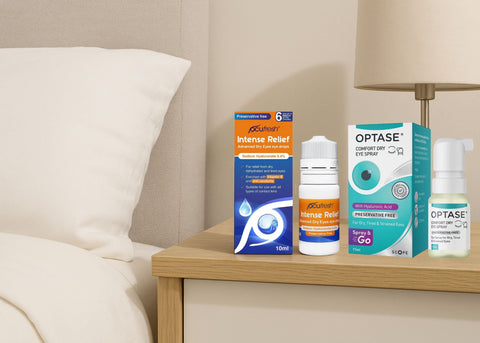Why your eyes feel sore, gritty, or just… tired
Struggling with dry, irritated, or red eyes? You’re far from alone.
From endless screen time and air‑conditioning to allergies, contact lenses, and urban pollution, modern life is a recipe for eye discomfort. In fact, dry eye disease affects up to 49% of the global population according to recent studies (Craig et al., 2023).
Most people instinctively reach for artificial tears, but if you’ve tried drops and still feel that annoying “scratchy” sensation, you’re not imagining things. Many conventional drops only address one part of the problem.
Here’s why…
How your tear film really works (and why drops don’t always fix it)
Your eye’s tear film isn’t just water. It’s a complex, protective structure made of three layers:

This is where new alternatives like eye sprays and preservative‑free drops come in.
Two modern solutions backed by science
Eye Spray: Lipid layer support without the awkward drop
Unlike traditional drops, sprays are applied to closed eyelids. One example, glycerin‑based sprays, has shown impressive results:
-
A 2021 clinical trial (Sjöstrand et al.) found lipid sprays improved tear film stability and reduced dry eye symptoms in as little as two weeks.
-
Glycerin, a key ingredient, blends with natural eyelid oils and spreads across the eye when you blink, reinforcing the lipid layer and reducing evaporation.
Why people love it:
-
Hands‑free: Perfect for those who dislike putting drops directly in their eyes.
-
Portable: No mirror required, easy for screen-heavy days or travel.
-
Dual benefit: Hydrates the eyelids and tear film simultaneously.
💡 Pro tip: Eye spray is particularly helpful for people with evaporative dry eye or those who wear contact lenses and need a fast, non‑intrusive boost of comfort.
Preservative‑Free Eye Drops: Hydration plus protection
While many artificial tears simply add water, modern preservative‑free drops go further. For example, ectoine‑based drops (like Optase Allegro) are backed by multiple studies:
-
A 2023 environmental irritant challenge trial demonstrated that ectoine drops significantly reduced redness, itchiness, and watery eyes, especially in allergy‑prone users (Eyes On Eyecare, 2023).
-
Ectoine works by forming a “hydration shield” around ocular surface cells, protecting them from oxidative stress and environmental triggers.
And then there are basic preservative‑free lubricating drops (like Ocufresh), which act as safe, frequent-use artificial tears. Though simpler in formulation, research shows that preservative‑free lubricants remain the first-line treatment for dry eye relief (TFOS DEWS II, 2017).
Why people use preservative‑free drops:
-
Safe for frequent, long-term use (especially for contact lens wearers).
-
Immediate relief from dryness and irritation.
-
Compatible with other therapies, like eye sprays, for layered protection.
Clinical & real-world comparisons

How to build a dry eye relief routine (expert-backed)
Managing dry eye is about more than just one product. Ophthalmologists recommend a layered approach:
-
Cleanse your lids daily: Use lid wipes or warm compresses to keep meibomian glands clear.
-
Apply eye spray 2–4x/day: Boost lipid layer stability.
-
Add drops as needed: Use preservative-free options to hydrate and protect.
-
Optimise your environment: Blink more during screen use, stay hydrated, and avoid overly dry air.
-
Nutrition counts too: Omega‑3 supplements have been linked to improved tear film quality in some studies.
Safety first: What the research says
Both sprays and preservative-free drops are considered safe for most users:
-
Preservative-free formulations are crucial for anyone using eye products long term, especially in chronic conditions like blepharitis or meibomian gland dysfunction.
-
Clinical trials on ectoine have reported minimal, self-limiting side effects (Eyes On Eyecare, 2023).
-
For contact lens wearers, most sprays can be used while lenses are in, but always check the product packaging for specific recommendations.
The future of dry eye care is nearly here
If you’ve ever felt that traditional drops alone weren’t enough, science now offers smarter solutions.
Eye sprays are emerging as a game-changer for evaporative dry eye, while preservative-free drops remain the gold standard for hydration and protection. Together, they represent a modern, layered approach to lasting eye comfort.
Coming soon: Optase Comfort Dry Eye Spray and Ocufresh Drops, designed to fit exactly into this new, research-backed routine.
Want to be the first to know when they launch?
Register your interest here and get early access to updates, expert tips, and launch news.
Your eyes deserve gentle, lasting comfort, and the future is almost here.
How we reviewed this article:
Ocushield has strict sourcing guidelines and relies on peer-reviewed studies, academic research institutions, and medical associations.
- Findlay (2018) Dry Eye Review fplreflib.findlay.co.uk/images/pdf/optician/dry-eye-2018.pdf
- Imed Pharma (2021) Global Dry Eye Syndrome Therapeutics Market Report imedpharma.com/wp-content/uploads/2021/11/Global-Dry-Eye-Syndrome-Therapeutics-Market-Report-Forecasts-Upto-2025_Axiom-MRC_Corporate-License.pdf
- Dry Eye Rescue (2025) Optase Dry Eye Spray Product Overview dryeyerescue.com/products/optase-dry-eye-spray
- PubMed (2024) Ectoine Protects Against Inflammation in Ocular Surface Disease pmc.ncbi.nlm.nih.gov/articles/PMC10892505/
- Journal of Cataract and Refractive Surgery (2025) Efficacy of Sodium Hyaluronate Combined With Ectoine journals.lww.com/jcor/fulltext/2025/04000/efficacy_of_0_1__sodium_hyaluronate_combined_with.7.aspx
- PubMed (2021) Efficacy of Ectoine Eye Drops for Dry Eye Management pubmed.ncbi.nlm.nih.gov/33628826/
- Optometry Advisor (2023) Ectoine Drops for Dry Eye and Allergy www.optometryadvisor.com/reports/ectoine-drops-can-manage-combined-atopic-keratoconjunctivitis-dry-eye/
- PubMed (2021) Effect of Phospholipid Liposomal Sprays on Tear Film Stability pmc.ncbi.nlm.nih.gov/articles/PMC8294836/
- Hilco Vision (2025) Optase Comfort Dry Eye Spray ado.hilcovision.com/f/optase-comfort-dry-eye-spray
- PubMed (2017) Mechanisms of Tear Film Dysfunction in Dry Eye Disease pmc.ncbi.nlm.nih.gov/articles/PMC5655476/
- Wikipedia (2025) Artificial Tears en.wikipedia.org/wiki/Artificial_tears
- Wikipedia (2025) Dry Eye Syndrome en.wikipedia.org/wiki/Dry_eye_syndrome
Our experts continually monitor the health and wellness space, and we update our articles when new information becomes available.
Written By
Erika

Leave a comment